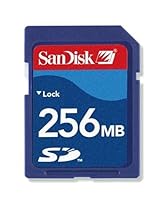
SanDisk SDSDB-256-A10 256 MB Secure Digital Card (Retail Package)
From SanDisk
The SD memory card was designed by the consortium of Matsushita Electric (Panasonic), SanDisk and Toshiba and is now supported by the SD Association, an open industry standard organization comprised of over 500 members. The SD card is ideally suited to meet the demands of small portable devices that need high capacity flash memory in a very small size.
- Brand: SanDisk
- Model: SDSDB-256-A10
- Platform: Not Machine Specific
- Original language: English
- Number of items: 1
- Dimensions: 7.90" h x 1.20" w x 5.00" l, 1.00 pounds
SanDisk's 256 MB Secure Digital (SD) memory card includes a high-performance, 9-pin SD interface that enables data transfer rates of up to 10 MBps. Its proprietary interface commands facilitate the secure exchange of content between host devices, such as PCs and music servers, and the card itself. The security level provided in the SD memory card has been designed to comply with current and projected SDMI (Secure Digital Music Initiative) portable device requirements.
The SD Card is a highly secure stamp-sized flash memory card. Jointly developed by Matsushita Electronic (best known for its Panasonic brand name products), SanDisk and Toshiba, the SD Card weighs approximately two grams. The SD Card can be used in a variety of digital products; digital music players, cellular phones, handheld PCs (HPCs), digital cameras, digital video camcorders, smart phones, car navigation systems and electronic books. This model has enough storage to hold more than four hours of compressed music, or hundreds of digital pictures.
Secure
Cryptographic security for copyrighted data based on proven security concepts from DVD audio. Security level complies with both current and future Secure Digital Music Initiative (SDMI) portable device requirements. The cards also have a user-selectable mechanical write protect switch on the exterior card casing.
Fast
High transfer rate for fast copy/download operations.
Efficient
High storage capacity, with non-volatile solid-state memory that has no moving parts to conserve battery power and maximize battery life in small portable devices. The card has an operating shock rating of 2,000Gs, equivalent to a 10-foot drop to the floor.
Compatible
New devices with SD Card slots will accept existing MultiMediaCards.
Get a Lexar![]()
If you search around on the Web (e.g., brighthand, pocketpc thoughts...) you'll see that quite a number of users have problems with Sandisk memory cards. They used to be the cheapest, but not any more. For the same price (or even lower), you can get much-better-quality memory cards from Lexar. I highly recommend Lexar for reliability, speed, and lower power consumption.
Not all digital devices work with all SD cards![]()
There are a number of people leaving reviews here that bash SanDisk, and I'm sure that their experience justifies their opinions. But let me relate my own experience.
I bought a couple of motion-activated trail cameras and bought several Kingston 256MB SD cards for them. I decided on Kingston based on so many favorable reviews of their SD cards on Amazon. But the cameras were not compatible at all with the Kingston cards. The cameras wouldn't power up in the manner that the user manual said they would, I couldn't access the menu screen, none of the set-up buttons worked, and the LCD screens showed things never discussed in the user manual. Things were just generally screwed up, and I wondered if I had received a defective unit.
I called the camera manufacturer and they said that they also had experienced trouble with certain "offbrand" makes of SD cards, but that they hadn't had any trouble with SanDisk. I had never heard that Kingston was considered an offbrand, but I decided to experiment using another manufacturer's SD card. I inserted a SanDisk SD card, and the camera worked beautifully. Perhaps SanDisk adheres more closely to guidelines for cross-compatibility between digital devices, but that was a lesson for me.
Contrary to the experiences of some, I have never had problems with a SanDisk memory card - CF or SD - whereas this is the second time I've had problems with a Kingston memory card - one time it was a 512MB CF card that suddenly went belly-up after not much use, and now their 256MB SD card was having compatibity issues. I'm sticking with Sandisk or Lexar.
An exelent card, but does not come formatted.![]()
I use the one of this size and brand card that was included with my SanDisk cruzer reader. The card is extremely fast, and is extremely reliable. I also noticed that the SanDisk Cruzer worked a lot faster than my digital camera, so it's a good buy for a few extra bucks if you want to get that.
There are two reasons many people have had trouble with Sandisk SD cards.
First, the obvious, like any storage device, it must be formatted before use.
The reason SanDisk does not format the card in the factory, is likely due to the fact that it takes longer to manufacture that way. Second is that some items, such as some digital cameras, must reformat cards. There are also the issues of FAT16, FAT32, or VFAT (FAT32 with long filenames, etc.) Most PDAs would want VFAT, but many digital cameras can't handle it, and some even require the older DOS FAT16 format, as it is much easier to handle with small processors.
Additionally the SD card standard is designed that some devices will accept a maximum size, or only a certain size. Many earlier Palm PDAs only supported 64MB, but most newer ones support more.


